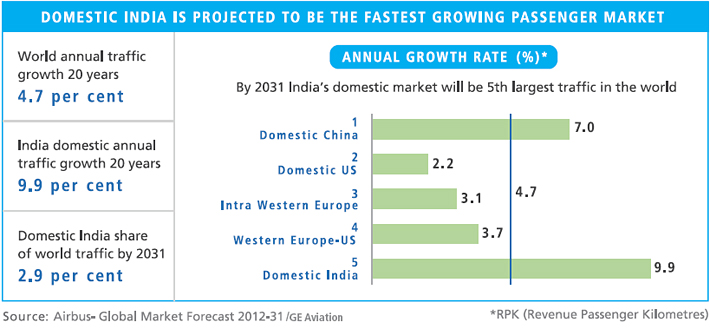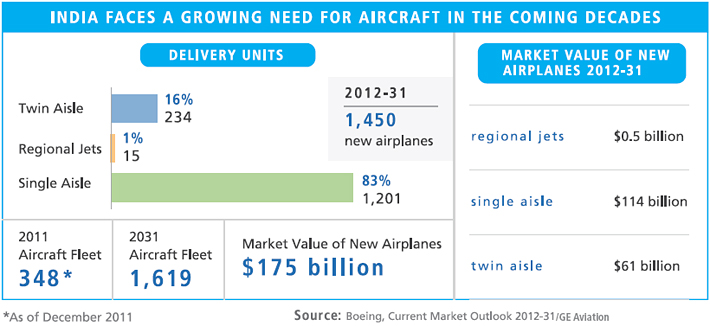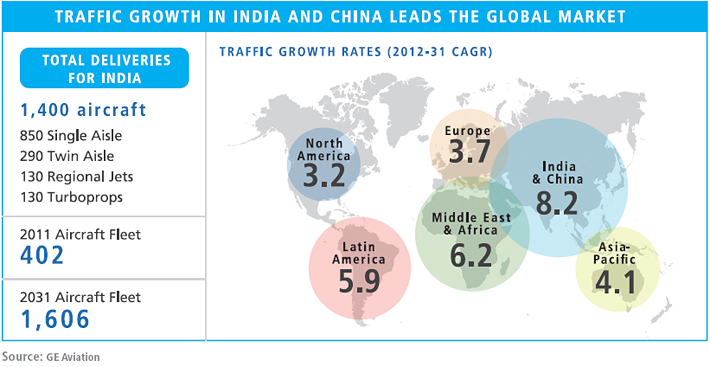INDIAN ARMED FORCES CHIEFS ON
OUR RELENTLESS AND FOCUSED PUBLISHING EFFORTS

SP Guide Publications puts forth a well compiled articulation of issues, pursuits and accomplishments of the Indian Army, over the years

I am confident that SP Guide Publications would continue to inform, inspire and influence.

My compliments to SP Guide Publications for informative and credible reportage on contemporary aerospace issues over the past six decades.
Rise of The Middle Class
Increasing trade and the emergence of middle classes in Asia, Latin America and Africa are driving the need for greater connectivity within these regions and the International Air Transport Association has estimated that 6,250 new jets valued at $300 billion (70 to 130-seat category) will be delivered in the next 20 years

The burgeoning middle class globally and mostly accounted for by China and India has been described by the United Nations as a tectonic shift not seen for 150 years. It was estimated that there were 1.8 billion middle class in 2009 and expected to touch 3.2 billion by the end of the decade. As per the World Bank, 72 per cent of the world population lived in middle income countries (MICs) in 2011 as against 22 per cent in 1990 and 45 per cent of the world GDP originated in MICs as against 21 per cent.
It is truly the rise of the middle class
Who comes under the middle class category? While the definition of middle class will vary from developed to developing countries, the World Bank has classified economies into different income groups that include categories such as low annual income – $1,005 or less; lower middle income – $1,006-3,975, upper middle income – $3,976-12,275 and high income – $12,276 or more. Another study said that the middle class is one which earns or spends $10 to $100 per day and is consuming things such as home appliances, cars, etc. Add to that air travel which was unheard of till recently.
When economies are growing, personal disposable income rises, too. Increasing trade and the emergence of middle classes in Asia (especially China and India where the population is 1.4 billion and over 1.2 billion respectively), Latin America, and Africa are driving the need for greater connectivity within these regions and the International Air Transport Association (IATA) has estimated that 6,250 new jets valued at $300 billion (70 to 130-seat category) will be delivered in the next 20 years.
Low-cost and Regional airline demand
IATA states that as the world recovers from the 2008 economic contraction, demand for air travel is expected to vary widely. All eyes are on Asia where the growth of revenue passenger kilometres will outpace the traditionally strong North American and European markets. The large number of low-cost/low-fare Asian airlines, which flew half of all ASKs in ASEAN countries last year, shows how carriers are quick to tap into the pent-up demand in that part of the world.
Large jets will continue to link main cities in emerging markets, but there is also new demand forecast to secondary markets. Aircraft with 70 to 130 seats have proven to be a cost-effective and efficient option for carriers to serve city pairs with lower demand. As traffic builds, airlines can add frequencies and carefully control overall route capacity and passenger yields. One carrier that has been particularly successful with this business strategy is Brazil’s Azul Airlines. It operates a fleet of over 80 Embraer E-Jets on a domestic network linking secondary cities with high-frequency, low-fare flights. Kenya Airways is tapping into air travel demand from Africa’s new middle class by using its fleet of E-Jets to add flights in existing markets and open new routes to/from Nairobi. As the middle class grows in China’s western provinces thanks to development of a resource and tourism-based economy, Tianjin Airlines is using its smaller capacity E-Jets to build a local regional network. And Air Costa, a start-up airline barely a year old, is bypassing the intensely competitive main cities in India in favour of a secondary-market approach to capture demand from that country’s rising middle class.
Also there is a huge shift in demographics. Migration has been from rural to Tier-II, Tier-III and mega cities, and this phenomenal growth is causing train on the whole civil aviation ecosystem. The need to develop quickly small functional airports and other infrastructure has become urgent and so is the deployment of low-cost carriers and regional carriers.
Explosive growth of middle class in China
McKinsey in a report has said that the explosive growth of China’s emerging middle class has brought sweeping economic change and social transformation – and it’s not over yet. It states that by 2022, over 75 per cent of China’s urban consumers will earn $9,000 to $34,000 a year. In the decade ahead, the middle class’s continued expansion will be powered by labour market and policy initiatives that push wages up, financial reforms that stimulate employment and income growth, and the rising role of private enterprise, which should encourage productivity and help more income accrue to households. Should all this play out as expected, urban-household income will at least double by 2022.



The report points out that the middle class growth will be stronger in smaller, inland cities than in the urban strongholds of the eastern seaboard. The evolution of the middle class means that sophisticated and seasoned shoppers—those able and willing to pay a premium for quality and to consider discretionary goods and not just basic necessities—will soon emerge as the dominant force.
Smaller cities get into the act
In 2002, 40 per cent of China’s relatively small urban middle class lived in the four Tier-I cities: Beijing, Shanghai, Guangzhou and Shenzhen. By 2022, the share of those megacities will probably fall to about 16 per cent. They won’t be shrinking, of course; rather, middle class growth rates will be far greater in the smaller cities of the north and west. Many are classified as Tier-III cities, whose share of China’s upper-middle class households should reach more than 30 per cent by 2022, up from 15 per cent in 2002.
That would mean enhanced multi-mode transport connectivity.
Air transportation, both passenger and cargo, is a critical element in the growing middle class and consequently the economy. Keeping this growth in mind, Brazilian aerospace major Embraer has forecast that 1,020 new 70 to 130-seat jets will be demanded by the Chinese regional aviation market by 2033, representing 16 per cent of global deliveries of jets in that segment.
Regional players bet big
“Consensus has been reached that regional aviation plays a significant role in improving the connectivity, fostering economic advances and enhancing the social welfare of China’s remote areas. Development of regional aviation is also important for building China into an aviation powerhouse,” said Guan Dongyuan, Senior Vice President of Embraer and President of Embraer China. “As the world’s largest manufacturer of jets up to 130 seats, Embraer has been, and will continue to be committed to the development of China’s regional aviation, jointly with our industry peers.”
As forecasted, in the coming two decades, air travel in China will increase 6.8 per cent annually, fostered by the country’s sustained economic growth, with an expected 5.5 per cent annual GDP growth rate. Fast urbanisation and a growing middle class will also contribute to building China into one of the world’s fastest growing markets.
Regional aviation, supported by civil aviation policies over the past decade, is experiencing rapid development and playing an irreplaceable role in the air transport system. With the launch of the ‘Essential Air Service’ programme, the improvement of incentive policies, and more regional airports coming online in central and western China, the regional aviation sector is assured a promising future.
Yet, by an in-depth analysis of the current market weaknesses and insufficiencies, the outlook finds that the mismatch between market demand and aircraft type results in poor connectivity and lower frequencies, while airlines call for right-sized aircraft to unlock the huge potential in the country’s secondary and tertiary markets, and to avoid irrational and unhealthy competition both on trunk lines and in regional aviation. The new generation of 70 to 130-seat regional jets, with lower operating cost and high performance, can be used in different business models.
Embraer projections

The projection is for 300 70/90-seat jets and 720 90/130-seat jets. 87 per cent of new deliveries will be deployed to support market growth, while 13 per cent will replace old aircraft in the current fleet, which includes 50-seat airplanes.
Since the first Embraer jet was delivered to the China market, Embraer has logged 216 firm orders, to date, including 181 commercial jets. Over 100 Embraer commercial jets are currently flying on more than 600 routes serving over 130 cities in this country. Embraer now has an 80 per cent share of China’s regional aviation market.
Upwardly mobile India
There is large untapped potential for growth in the Indian aviation industry due to the fact that access to aviation is still a dream for nearly 99.5 per cent of its large population, nearly 40 per cent of which is the upwardly mobile middle class. It is critical for the industry stakeholders to engage and collaborate with the policy makers to come up with efficient and rational decisions that will shape the future of the Indian civil aviation industry. With the right policies and a relentless focus on quality, cost and passenger interest, India would be well placed to achieve its vision of becoming the third largest aviation market by 2020 and the largest by 2030.
India’s scheduled airlines carried 67.73 million passengers in 2014 compared with 61.42 million passengers in 2013, and 58.81 million in 2012, according to the DGCA. Air traffic in India grew between 20 and 40 per cent for six years starting 2003, when lowfare airline Air Deccan was launched, making it possible for more people to travel by air.
Higher disposable incomes, an expanding middle class and rapid urbanisation have made India one of the world’s fastest growing domestic aviation markets, where passenger numbers are expected to grow by more than 75 per cent in the next six years to exceed 217 million.
That trend is set to continue as more airports are built in smaller cities. This month, Prime Minister Narendra Modi’s Government picked five smaller cities to kick off a nationwide initiative to build about 50 new airports. Air travel penetration in India remains small in global terms, with 0.04 annual trips per capita against 0.3 in China and more than two in the United States. But that is all going to change in the near future.





